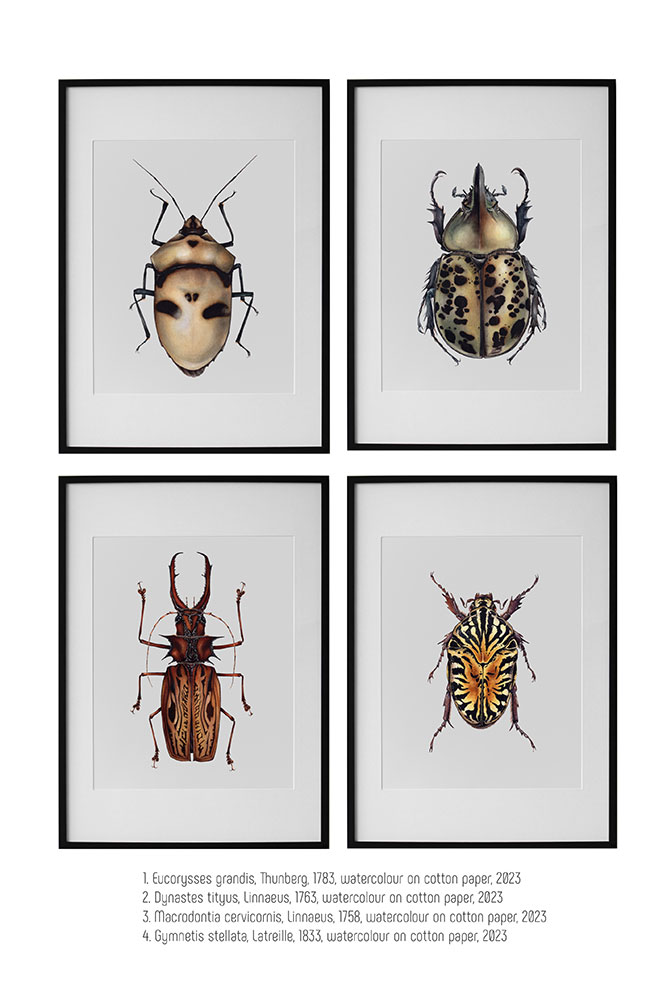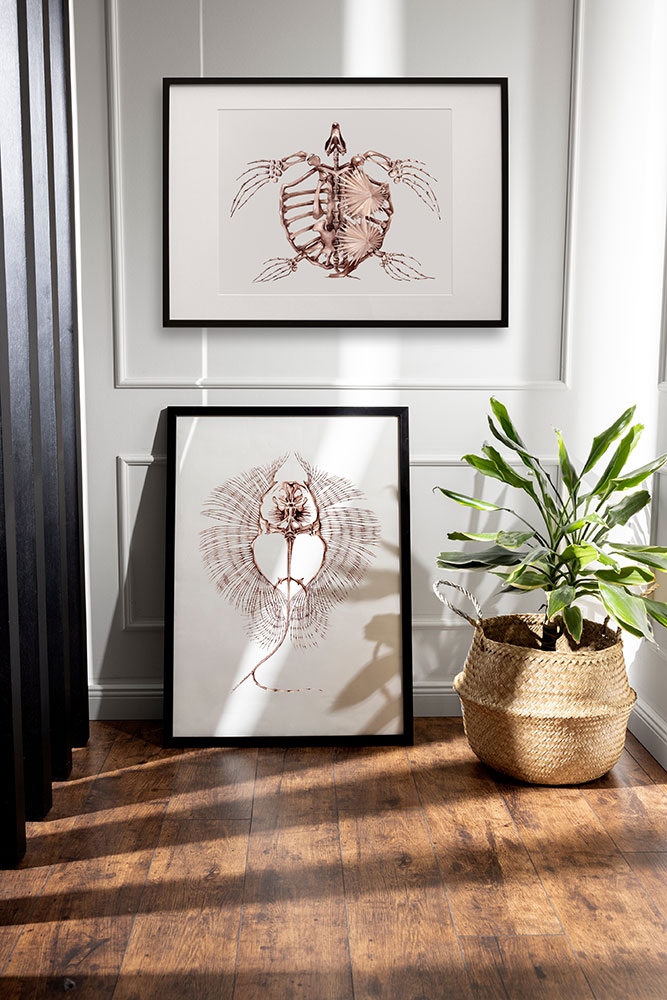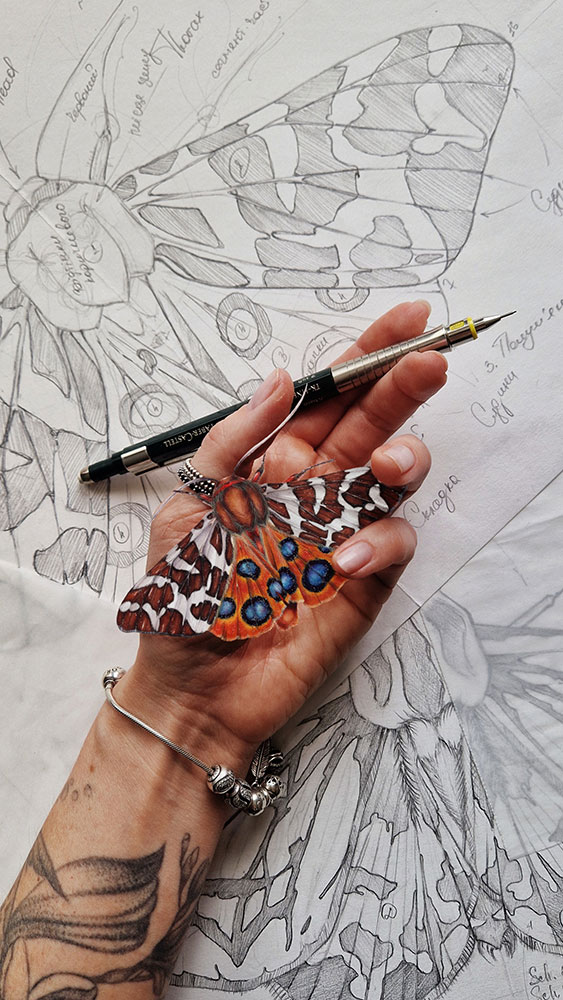Evolution is the best artist. It creates perfect functionality enclosed in perfect form. The artist only transfers these masterpieces from natural history museums to art galleries.
ASBA, ASB member, natural history illustration teacher
Born: Kharkiv, Ukraine
Now: Lviv, Ukraine
@motheroffossildragons
INTERVIEW
Katya, since you work within a historical and temporal context, let’s talk about the origins – when did you become seriously interested in art, and when did you recognize yourself as an artist?
It’s a difficult question. I don’t think there was a moment when I woke up and thought “oh, I’m an artist now”. It was a very organic process. I don’t remember when exactly I started drawing. I think it was at around the age 4. Of course, it wasn’t a conscious decision, it was more of a normal way for a child to learn about the world. However it consumed me completely and brought some chaos to the family, haha. That’s why I was sent to a children’s art club full time until I started going to school. My first exhibition experience happened at the age of 9. It was a children’s art competition organized by the gallery FOURTH BLOCK and was dedicated to the tenth anniversary of the Chernobyl tragedy.
The management of my school was very supportive of my creative expressions and throughout my school years I continuously participated in art competitions.
After finishing school, my priorities had shifted for several years and I did not paint for competitions and exhibitions.
Nevertheless it lived in me and demanded realization. As a result, I returned to the origins and now my life consists of drawing and art teaching.
Now I can share my knowledge and it’s amazing that people respond and want to learn entomological illustration.

When speaking about yourself, you mention awakening an interest in paleo and wildlife art during childhood. Tell us what fascinated you about this direction and what continues to inspire you!
I am from Kharkiv, so my first contact with natural curiosities was in Kharkiv Natural history museum. I was a child, the “Jurassic Park” just came out, so of course I was looking for dinosaurs. However they weren’t there. I asked a museum guide “where are the dinosaurs?” – “probably they didn’t live here” he replied. I thought it was sad, but it really interested me. Although this is not entirely true. A lone dinosaur from the genus Hadrosaurid was found in Crimea, but Russia appropriated this find, literally stole it along with Crimea. A watercolour reconstruction of his skeleton will be on display in the part of my exhibition that will be presented in the paleontology hall.
Actually bones and insects are not my only sources of inspiration. I graduated from the science class, where I studied biology, chemistry, physics and the basics of Latin in depth. I started drawing plants in a “museum” way since my school days. Three factors collided for this: the drawing elective, the presence of its own greenhouse in the gymnasium, and the fantastic herbarium of the beginning of the 20th century, which was kept in the biology department. It happened that plants interested me not only in their appearance – I found no less beauty looking at their cells under a microscope.

Your works are indeed very beautiful! How did you develop such a detailed drawing style? Is the secret in love or in hours of studying special textbooks and practice?
First of all, thank you very much. It is very important for me that my works evoke pleasant emotions in the viewers. This is the main motivation for me.
For me, the most important thing is a sincere love for the object of drawing. I don’t just love nature, I admire it. It creates perfect objects. As for the technique of execution, it is practice, a lot of practice and of course research. It is not enough to just find a beautiful photo and mindlessly copy it. Masterpieces of nature deserve of being studied in detail. Because of this, I visit museums, read a lot of reference literature, and try to study biology. That is why I have been working with a personal mentor, a professional biologist, for many years now, who helps me systematize my knowledge. Anatomical accuracy is incredibly crucial to me. It goes without saying that such detailed work is a kind of meditation and escapism that helps me not to go mad in our difficult times.
It was unexpected and literally mind-blowing. A few weeks before the offer from the museum, I wrote a post about my art path dreams, and the biggest one was to work with the main natural history museum in Ukraine. As I have said, I have been a fan of such places since childhood. In Kharkiv, I saw fossils of a plesiosaurus flipper for the first time and this confirmed my love for fossil dragons. You might have noticed this from my Instagram nickname, haha. In the Kyiv museum, I was impressed by the collection of insects. It’s fantastic! I made many sketches from exposition, and over the time they transformed into a large collection of watercolor artworks, which can be seen on the walls of the The National Museum of Natural History at the National Academy of Sciences of Ukraine from the end of July. It is a great honor for me to display my works next to real museum exhibits from all over the world.

Soon, your personal exhibition of paleo and entomology illustrations will open at the Kiev Museum of Nature. How did the idea for the exhibition form, and how did you manage to arrange it with the museum? Share the details of the exhibition preparation!
It was unexpected and literally mind-blowing. A few weeks before the offer from the museum, I wrote a post about my art path dreams, and the biggest one was to work with the main natural history museum in Ukraine. As I have said, I have been a fan of such places since childhood. In Kharkiv, I saw fossils of a plesiosaurus flipper for the first time and this confirmed my love for fossil dragons. You might have noticed this from my Instagram nickname, haha. In the Kyiv museum, I was impressed by the collection of insects. It’s fantastic! I made many sketches from exposition, and over the time they transformed into a large collection of watercolor artworks, which can be seen on the walls of the The National Museum of Natural History at the National Academy of Sciences of Ukraine from the end of July. It is a great honor for me to display my works next to real museum exhibits from all over the world.

You are a member of several international associations. Soon, you will participate in an exhibition by the American Society of Botanical Artists. What was the path to joining the association, and how did you manage to pass the selection?
Unfortunately, many people are afraid even to try. Afraid of rejection or judgment. Often this is a direct consequence of trauma inflicted by incompetent teachers. It is terrible. It should not be like this. Every artist deserves to be seen and heard. As a teacher, I always emphasize to students the importance of believing in themselves. You will not know what you are capable of without trying.
Membership in international associations is a great responsibility, because your works often form an opinion about the entire Ukrainian botanical or natural history art community on the international arena. What is more it is also access to knowledge, exchange of experience, acquaintance with fantastically talented people from all over the world.
My advice is to try. Perhaps not to apply for membership in the association right away, but to start with open calls. Getting feedback from a competent jury of the best representatives of the genre is very valuable. Every small step brings you closer to your goal. Often people don’t even realize HOW talented they are and they need that push from recognized masters.

What advice would you give to aspiring artists? What do you think is the secret to success and personal growth?
The advice to work hard sounds trite, but it works. Never stop learning, challenge yourself, practice hard every day. I don’t just mean working at a desk. I’m talking about expanding your horizons, gaining new knowledge.
As soon as a person says “I know everything” it’s a dead end, that’s it, that’s the end. This is a lie to yourself first and foremost. As long as you tell yourself “I want more”, more knowledge, more skills, more freedom of imagination, you continue to move forward.
It’s important, even vital to stand your ground. Don’t let anyone devalue you or compare you with the others. Each of us is unique, and each creative path is unique as well. The main thing to remember is that before you start breaking the rules, you need to learn them first, haha, in other words you can’t skip the fundamental theoretical foundations.
